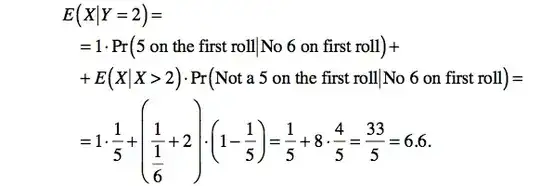A fair die is rolled repeatedly. Let $X$ be the number of rolls needed to obtain a 5 and $Y$ the number of rolls needed to obtain a 6. Calculate $E[X \mid Y=2]$.
I found a similar post of this same question here: A question on conditional expectation But I still do not understand the solution after reading it. If someone could hold my hand a little and provide a more thorough explanation I would really appreciate it.
This is what's going through my head:
Since $Y=2$, we roll a 6 on the second roll, meaning that we do not get a 6 on the first roll. Therefore, the first roll has a uniform distribution of the set $\{1,2,3,4,5\}$. We also know that $\Pr(X=2 \mid Y=2)=0$ because these events are mutually exclusive. We can apply the definition of expected value now and I let $Z=X \mid (Y=2)$.
$E[Z]=\sum\limits_{z=1,z \ge 3}^{\infty} z \cdot \Pr[Z] \tag{1}$
Now:
$\Pr[Z=1]=\Pr[X=1 \mid Y=2] = \Pr[5 \text{ on first roll} \mid 6 \text{ on second roll}]=1/5$
$\Pr[Z=2]=0$ as mentioned above.
Now I get confused when I calculate probabilities for $Z \ge 3$, and would appreciate some guidance:
$\Pr[Z=3]=\Pr[X=3 \mid Y=2] =\Pr[5 \text{ on third roll} \mid 6 \text{ on second roll}]$
So to calculate this probability, I thought I'd break this case down:
Question 1: I thought the first roll only can be from the set: $\{1,2,3,4\}$. Second roll = 6, and Third roll = 5. But I think the solution to this probability is: $(4/5)(1)(1/6)$. I don't see why the probability of the first roll is (4/5) because for this case, we can only get a 6 on the second roll. Can someone please explain and perhaps illustrate another example like $Pr[Z=4]$?
Question 2: My approach then was to find the equation for $\Pr[Z \ge 3]$ and then apply equation (1) to get the solution. Is this the best approach? I was reading another solution but did not understand it:

Thanks in advance.